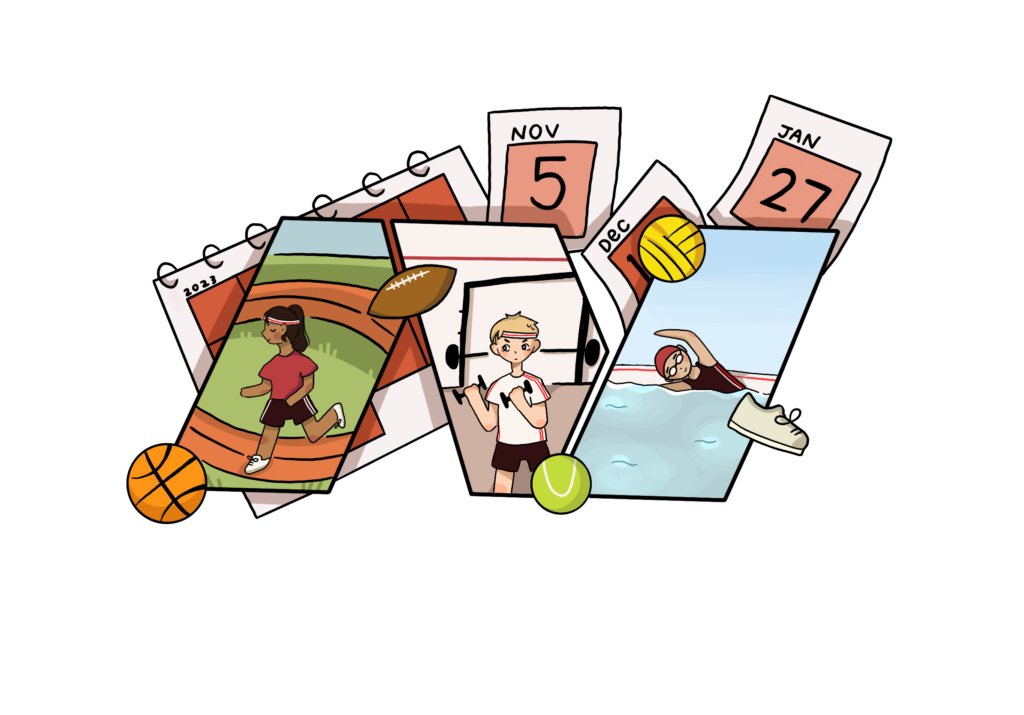
Lillian Huang
Great teams and great players aren’t built during the season. Great teams and players are built in the unseen hours and the work that they put in when no one is watching. These hours are the hidden foundation upon which success is constructed.
Athletic training can be grouped into three main categories: sport-specific training, conditioning and strength training. All three of these components are integral to performance in athletic contests.
Sport-specific training involves movements and drills that directly correlate to those carried out in athletic contests. This training focuses on developing techniques that are directly relevant to the sports. Whether it’s dribbling a basketball, perfecting a golf swing or mastering the art of a soccer kick, athletes invest significant hours into honing these skills. Athletes meticulously study the nuances of their sport and perfect their craft. Sport-specific training is often performed solo, with the exception of some athletes who play competitive sports outside of school or have trainers who work with them on developing skills.
Conditioning is purely based on endurance, involving athletes pushing themselves to their cardiovascular limits. Conditioning prepares athletes for grueling competition, giving them an extra step when they hit a plateau in cardiovascular and muscular efficiency while they compete.
Strength training is usually defined by progressively overloading certain muscle groups to improve athletes’ overall strength over time and includes flexibility and range of motion. Strength training is important for developing proper range of motion, mobility, posture and overall athleticism.
Offseason training isn’t just about training the body, as through these offseason workouts athletes learn to train their mind as well. Athletes train mentally by showing up day in and day out and doing the little things that amount to larger positive results. In this consistency, athletes develop discipline and intense focus, but developing this mindset is also extremely challenging.
“The time and effort that you put in doesn’t pay off right away,” said junior and track athlete Russell Yee. “Sometimes it’s tough to stay motivated and keep grinding.”
It’s not just the time investment that is burdensome for these dedicated athletes, it is also the toll on their bodies. In the offseason athletes have time to push themselves physically without having to worry about in-game performance. This allows them to both train harder and recover for longer periods of time than they would in season.
Another important aspect of offseason training is the cohesion of a team through shared adversity and a solid foundation of sacrifice. Athletes push themselves to their physical and mental limits during the offseason, and having a teammate next to you to pick you up when you fall really means a lot in terms of team building.
“Athletes are bonded through a shared struggle,” said strength and conditioning coach Mike Wu. “They see each other working and are motivated by each other’s success.”
The sheer amount of time spent together focused on one common goal also contributes to this team bonding that is achieved through offseason training.
Training with teammates connects to one key aspect of athletic performance, competition. In competing with teammates, athletes are more likely to hold themselves accountable and push themselves to their own limits to try to match their peers’ efforts.
“When I train with the team I can see other people outworking me, and that motivates me to outwork them,” said senior baseball pitcher Ben Strickley.
The time commitment does not go unrewarded; Wu noted that he sees athletes improve greatly both physically and mentally.
“Once you get the idea of working for something harder than someone else, and out of the mindset of making excuses for yourself, you really start to see your athletic performance take off,” Wu said.
Athletes also notice that the time they put in during the offseason benefits them during the season.
“I put in one to three hours of work in six days a week, so seeing the time investment pay off is very rewarding,” Strickley said. “Even week to week and day to day, seeing myself improve is truly a great feeling.”
Offseason training is an integral part of athletic performance, and dedicated athletes at Aragon embrace the challenges of this rigorous training. Driven by a strong passion for their sport and competition with their peers, athletes push themselves in the offseason, planting the seeds of a fruitful tree. This tree, nurtured with their sweat and commitment, blossoms when the in-season competition arrives, casting a long shadow of their excellence and outstanding commitment to their craft.



